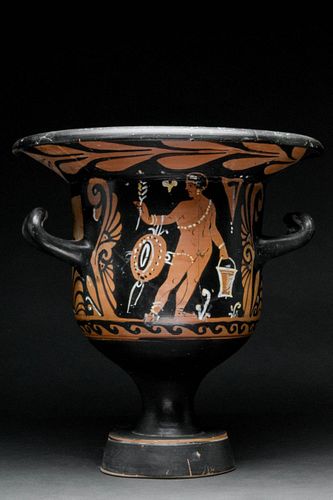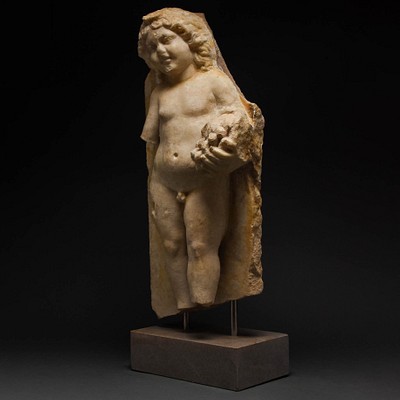APULIAN RED-FIGURE BELL KRATER - TL TESTED
Lot 20
Categories
Estimate:
GBP£10,000 - GBP£20,000
$12,820.51 - $25,641.03
Absentee vs Live bid
Two ways to bid:
- Leave a max absentee bid and the platform will bid on your behalf up to your maximum bid during the live auction.
- Bid live during the auction and your bids will be submitted real-time to the auctioneer.
Bid Increments
| Price | Bid Increment |
|---|---|
| GBP£0 | GBP£10 |
| GBP£100 | GBP£10 |
| GBP£200 | GBP£20 |
| GBP£500 | GBP£50 |
| GBP£1,000 | GBP£100 |
| GBP£2,000 | GBP£200 |
| GBP£5,000 | GBP£500 |
| GBP£10,000 | GBP£1,000 |
| GBP£20,000 | GBP£2,000 |
| GBP£50,000 | GBP£5,000 |
| GBP£100,000 | GBP£10,000 |
| GBP£200,000 | GBP£20,000 |
| GBP£1,000,000 | GBP£50,000 |
About Auction
By Apollo Art Auctions
Mar 27, 2022
Set Reminder
2022-03-27 08:00:00
2022-03-27 08:00:00
America/New_York
Bidsquare
Bidsquare : Ancient, Chinese and Islamic Art
https://www.bidsquare.com/auctions/apollo-art-auctions/ancient-chinese-and-islamic-art-8938
Apollo Galleries and Auctions is delighted to present a stunning March 2022 Ancient, Chinese and Islamic Art Auction. The sale is divided into four sections and features items from Christie’s, Bonham’s, Alison Barker, John Lee and other famous collections. Apollo Art Auctions enquiries@apolloauctions.com
Apollo Galleries and Auctions is delighted to present a stunning March 2022 Ancient, Chinese and Islamic Art Auction. The sale is divided into four sections and features items from Christie’s, Bonham’s, Alison Barker, John Lee and other famous collections. Apollo Art Auctions enquiries@apolloauctions.com
- Lot Description
Circa 430-300 BC, Apulia A beautiful terracotta bell krater features a pedestal foot, cylindrical flared stem, inverted bell-shaped body, two upturned handles and a wide, everted rim. A beautiful example of Apulian Plain style, probably depicting a Dionysiac thiasos, i.e. the ecstatic procession of Dionysus followers, often pictured as inebriated revellers. On side of the body shows a half-nude, seated woman holding a wreath and a phiale ready for wine to be poured in. The other side depicts a standing male figure holding a situla, a ritual vessel for libations, a tambourine, and a branch. The use of white paint for additional details, such as the jewellery of the woman, and as added highlights to the scenery is indicative of this vessel having been painted in Magna Graecia (the Greek colonies of Southern Italy). Bell kraters such as this fine example first occur in the early fifth century and the only extant ones have red-figure decoration. Bell kraters were named for their bell-like shape, perhaps originating in wood, and they usually featured small horizontal upturned handles just over halfway up the body such as in this example. Some did not have a foot, and earlier examples may have had lugs for handles. Over the course of the fifth and fourth centuries BC, the shape becomes slimmer. Kraters were used for diluting wine with water and usually stood on a tripod in the dining room, where wine was mixed during a banquet (symposium). For a comprehensive treatment of Apulian red-figure vases, see: Trendall A. D., Cambitoglou, A. (1978). The Red-figured Vases of Apulia: Early and Middle Apulian. Oxford: Clarendon Press. This piece has been precisely dated by means of a Thermo Luminescence analysis carried out by Ralf Kotalla, an independent German Laboratory. The samples collected date the piece to the period reflected in its style, whilst also showing no modern trace elements. The TL certificate with its full report will accompany this lot. Size: L:350mm / W:330mm; 3.1kg Provenance: Property of a central London Gallery; formerly in a South English estate collection; acquired in the 1990s from Andre de Munter, Brussels, Belgium; previously in an old European collection.
- Shipping Info
-
We offer in-house packing and international shipping at discounted rates.
-
- Buyer's Premium



 EUR
EUR CAD
CAD AUD
AUD GBP
GBP MXN
MXN HKD
HKD CNY
CNY MYR
MYR SEK
SEK SGD
SGD CHF
CHF THB
THB

















